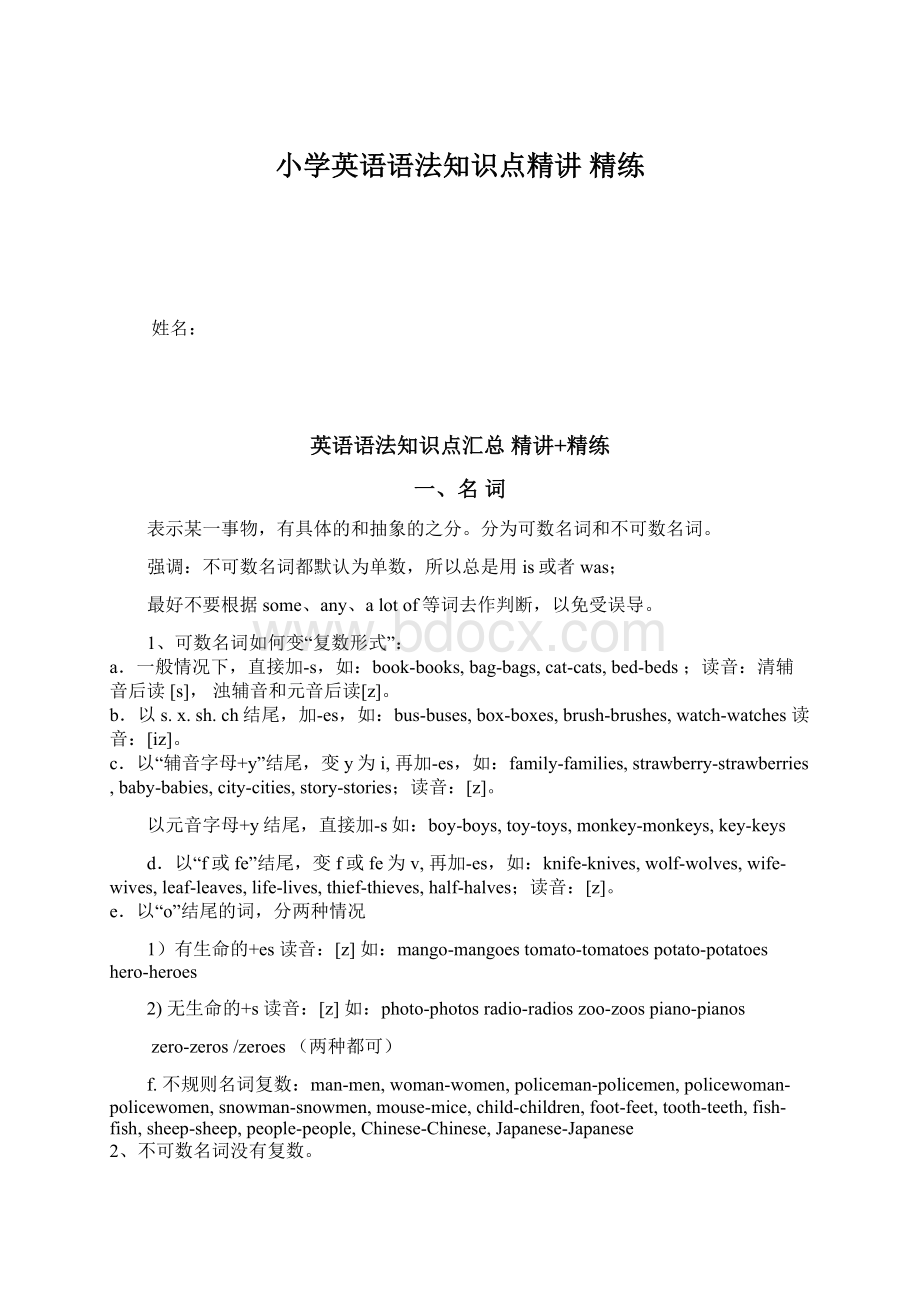 小学英语语法知识点精讲 精练.docx
小学英语语法知识点精讲 精练.docx
- 文档编号:447786
- 上传时间:2022-10-10
- 格式:DOCX
- 页数:40
- 大小:59.95KB
小学英语语法知识点精讲 精练.docx
《小学英语语法知识点精讲 精练.docx》由会员分享,可在线阅读,更多相关《小学英语语法知识点精讲 精练.docx(40页珍藏版)》请在冰豆网上搜索。

小学英语语法知识点精讲精练
姓名:
英语语法知识点汇总精讲+精练
一、名词
表示某一事物,有具体的和抽象的之分。
分为可数名词和不可数名词。
强调:
不可数名词都默认为单数,所以总是用is或者was;
最好不要根据some、any、alotof等词去作判断,以免受误导。
1、可数名词如何变“复数形式”:
a.一般情况下,直接加-s,如:
book-books,bag-bags,cat-cats,bed-beds;读音:
清辅音后读[s],浊辅音和元音后读[z]。
b.以s.x.sh.ch结尾,加-es,如:
bus-buses,box-boxes,brush-brushes,watch-watches读音:
[iz]。
c.以“辅音字母+y”结尾,变y为i,再加-es,如:
family-families,strawberry-strawberries,baby-babies,city-cities,story-stories;读音:
[z]。
以元音字母+y结尾,直接加-s如:
boy-boys,toy-toys,monkey-monkeys,key-keys
d.以“f或fe”结尾,变f或fe为v,再加-es,如:
knife-knives,wolf-wolves,wife-wives,leaf-leaves,life-lives,thief-thieves,half-halves;读音:
[z]。
e.以“o”结尾的词,分两种情况
1)有生命的+es读音:
[z]如:
mango-mangoestomato-tomatoespotato-potatoeshero-heroes
2)无生命的+s读音:
[z]如:
photo-photosradio-radioszoo-zoospiano-pianos
zero-zeros/zeroes(两种都可)
f.不规则名词复数:
man-men,woman-women,policeman-policemen,policewoman-policewomen,snowman-snowmen,mouse-mice,child-children,foot-feet,tooth-teeth,fish-fish,sheep-sheep,people-people,Chinese-Chinese,Japanese-Japanese
2、不可数名词没有复数。
如果要计算不可数名词所表达的数量,就得在数词和不可数名词之间加上“量词+of”。
例如:
aglassofwater,apieceofpaper,abottleofjuice
练
一练
1、写出下列各词的复数。
baby__________eye__________tomato_______library_________goose_________telephone_________I_______him_________ this_______
her______ watch_______ mango___child_______photo________diary______ day________ foot________dress________tooth_______
sheep______ box_______ strawberry_____thief_______engineer______peach______sandwich______ man______ woman_______leaf______people________
2、用所给名词的正确形式填空。
(1)Aretheretwo (box)onthetable?
(2)Icanseesome (people)inthecinema.
(3)Howmany (day)arethereinaweek?
(4)Here’refive (bottle)of (juice)foryou.
(5)This (violin)ishers.Those (grape)areoverthere.
3、分出下列单词中的可数名词和不可数名词
peachinkwaterzoosistercoffeeknifesnowiceteaorangefridgebusrainwindcarteachermusicearcolawatermeloncherry
可数名词:
不可数名词:
4、填入所给名词的适当形式
1.Wehavethree________(pen).
2.Thisisan__________(apple).
3.Whereisthe__________(pencil)?
4.Thereisalittle__________inthebottle(juice).
5.Areyoua__________(driver)?
Yes,Iam.
6.Thereareafew__________(watch)onthedesk.
7.Many__________(shelf)areinourschoollibrary.
8.Hehassome__________(ink).
9.The__________(girl)inredisMary.
10.Howmany__________(people)arethereinyourfamily?
Three.
5、选择题
()1.Thereis__________onthetable.
A.PlateB.aplateC.plates
()2.Icanseemany__________inthegarden.
A.flowersB.aflowerC.flowers
()3.The_____onthehillsareallwhite.A.sheepB.sheepsC.dog
()4.Thesenew_____areforyou.A.skirtB.shoeC.shirts
()5.Theclockhasthree______A.legsB.legC.faces
()6.Theyarenotinthesame_______.A.classB.classesC.familys
()7.Isthisyour_____?
A.akeyB.keysC.key
()8.Theyarehaving_____.A.aclassB.EnglishclassC.Chineseclass
()9.Therearesomany_____inthehall.
A.peoplesB.peopleC.apeople
()10.The_____hassomenicepictures.A.boysB.teachersC.child
()11.The_____aredancingattheparty.A.womanB.womenC.man
()12.The_____areinRoom408.A.studentB.astudentC.students
()13.Who’sthat_____?
She’smymother.
A.manB.womanC.women
()14.The_____arecatchingthethief.A.policemanB.policemenC.policemans
()15.Therearenew_____inmyschoolbag.A.knifeB.knifesC.knives
()16._____jacketisit?
Maybeit’s_____.
A.Who’s;TomsB.What;Tom’sC.Whose;Tom’s
()17.Thebooksarethe_____.A.teachers’B.teachersC.teacher
()18.Therearealotofchildrenintheparkon_____Day.
A.childrenB.Children’sC.Childrens’
()19.Isitthetwins’bedroom?
Yes,itis.It’s_____bedroom.
A.AnnandAnna’sB.Ann’sandAnna’sC.AnnandAnna
()20.Thatis_____dog.A.Tom’sB.TomsC.Tom
()21._____coatsareverypretty.
A.JimandTim’sB.Jim’sandTim’sC.JimandTim
()22.Theyaregoingtotheir_____homefordinner.
A.unclesB.uncleC.uncle’s
()23.Thebigroomis_____.A.thetwin’sB.twins’C.thetwins’
()24.March8this_____.A.Woman’sDayB.Womans’DayC.Women’sDay
二、冠 词
冠词是一种虚词,不能独立使用,通常放在名词的前面,分为“不定冠词”和“定冠词”两种。
1、不定冠词:
a、an。
用在单数名词前,表示“一个,一件……”。
an用在以元音“音素”开头的单词前。
如:
ane-mail,anorange,anarm,anoldman,anEnglishwatch,anhour,anumbrella…
abook,amap,auniversity,ausefulbook,
2、定冠词:
the。
用在单数或者复数名词前。
the没有具体意思,有时翻译为这、那。
它的基本用法:
(1)用来表示特指某(些)人或某(些)事物。
如:
Themaponthewallisnew.
(2)表示说话者双方都知道的人或事物。
如:
Lookatthepicture,please.
(3)表示再次提到前面谈过的人或事物。
如:
Thisisastamp.Thestampisbeautiful.
(4)用在表示世界上独一无二的事物前。
如:
thesun太阳 themoon月亮 theearth地球
(5)用在由普通名词构成的专有名词前。
如:
theGreatWall长城
(6)用在江河、湖海等专有名词前。
如:
theChangjiangRiver长江
(7)此外,序数词、形容词最高级、乐器名称等词前面和一些习惯用语中一般都用定冠词the。
如:
thefirstday,thebestboy,playthepiano,inthesameclass
- 配套讲稿:
如PPT文件的首页显示word图标,表示该PPT已包含配套word讲稿。双击word图标可打开word文档。
- 特殊限制:
部分文档作品中含有的国旗、国徽等图片,仅作为作品整体效果示例展示,禁止商用。设计者仅对作品中独创性部分享有著作权。
- 关 键 词:
- 小学英语语法知识点精讲 精练 小学英语 语法 知识点
 冰豆网所有资源均是用户自行上传分享,仅供网友学习交流,未经上传用户书面授权,请勿作他用。
冰豆网所有资源均是用户自行上传分享,仅供网友学习交流,未经上传用户书面授权,请勿作他用。


 国企会计岗位笔试试题及答案解析(分享).docx
国企会计岗位笔试试题及答案解析(分享).docx
 行政事业单位内部审计流程图(按照新内部审计准则).xls
行政事业单位内部审计流程图(按照新内部审计准则).xls
